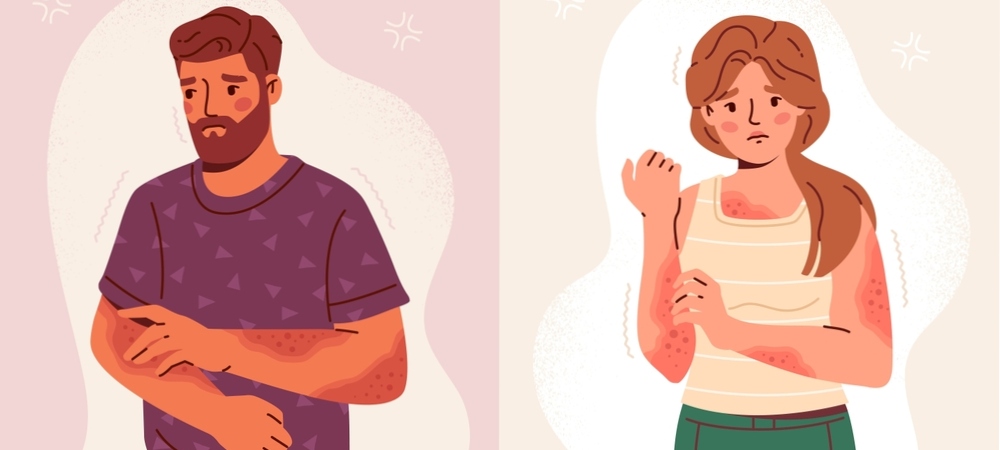Last Updated on July 14, 2023
Living with papular eczema can be a frustrating and challenging experience. The relentless itch, inflamed skin, and persistent discomfort can meddle with your physical and emotional well-being. However, understanding this condition and taking proactive steps can empower you to live beyond the itch. In this comprehensive guide, we will explore the ins and outs of papular eczema, from its causes and symptoms to practical tips for managing and minimizing its impact on your daily life. So, let’s dive in and discover the path to a more comfortable and fulfilling life.
What Is Papular Eczema
Papular eczema, also known as eczematous papules or papular dermatitis, is a form of eczema presenting small, raised bumps or papules on the skin. Moreover, it is a type of inflammatory skin condition that can cause itching, discomfort, and skin irritation. However, papules are solid, raised lesions that typically measure a few millimeters in diameter and have distinct borders. Furthermore, they may appear in clusters or scattered across the affected area.
The key characteristics of the condition include:
Papules
The primary feature of papular eczema is the presence of small, raised papules on the skin. However, these papules can vary in color, ranging from pink to red or even brownish.
Itching
Initially, intense itching often accompanies PE, which can be persistent and troublesome. Additionally, the urge to scratch the affected areas can worsen the condition and potentially lead to broken skin.
Inflammation
The affected skin areas can be inflamed, red, and swollen. However, this inflammation is a result of the underlying immune response triggered by the condition.
Distribution
Moreover, papular eczema commonly affects areas where skin surfaces come into contact, such as the flexor surfaces of the arms, legs, and neck. However, it can appear on any part of the body, including the hands, feet, and trunk.
Recurrence
Papular eczema tends to have a chronic and relapsing nature, with periods of flare-ups and remission. Additionally, factors such as stress, certain allergens, dry skin, or environmental irritants can contribute to recurrent episodes.
Common Triggers and risk factors
However, the condition is triggered by various factors, and certain individuals may be more susceptible to developing the condition. However, some common triggers and risk factors associated with papular eczema include
Allergens
Exposure to allergens, such as pollen, pet dander, dust mites, certain foods, or specific chemicals, can trigger papular eczema flare-ups in susceptible individuals. However, identifying and avoiding these allergens can help manage the condition.
Irritants
Contact with irritants, including harsh soaps, detergents, certain fabrics, fragrances, and chemicals, can exacerbate the condition’s symptoms. Hence, minimizing contact with irritants or using protective measures can help reduce flare-ups.
Dry Skin
Dry skin lacks moisture and can become more susceptible to papular eczema. Moreover, cold weather, low humidity, excessive bathing, and using hot water can strip the skin of its natural oils, leading to dryness and flare-ups.
Stress
Emotional stress, anxiety, and high levels of stress can contribute to papular eczema flare-ups. However, stress management techniques, such as relaxation exercises, mindfulness, and counseling, can reduce the impact of stress on the condition.
Genetic Factors
There is evidence of a genetic predisposition to eczema. Moreover, if you have a family history of eczema, atopic dermatitis, or other allergic conditions, your risk of developing the condition may be higher.
Hormonal Changes
Furthermore, hormonal fluctuations, particularly during puberty, pregnancy, or menopause, can influence papular eczema symptoms in some individuals.
Environmental Factors
Environmental factors such as exposure to extreme temperatures, humidity changes, pollution, and certain occupational hazards can trigger or aggravate papular eczema.
Scratching and Friction
Persistent scratching or rubbing of the affected skin can worsen the condition’s symptoms and lead to further irritation and inflammation. Moreover, friction caused by tight clothing or rough fabrics can also trigger or exacerbate symptoms.
Signs and Symptoms
 Identifying papular eczema
Identifying papular eczema
Eczema is a term used to describe a group of inflammatory skin conditions. However, there are different types of eczema, some common identification factors include:
Rash
Eczema presents a rash on the skin. Furthermore, the rash can vary in appearance depending on the type of eczema, but it often includes redness, inflammation, and itching. In addition, the rash may be patchy, dry, scaly, or have raised bumps.
Itching
Intense itching is a hallmark symptom of eczema. Moreover, the urge to scratch can be overwhelming and may lead to further skin irritation and potential complications.
Dryness
Eczema-prone skin tends to be dry and easily affected by environmental factors. The skin may feel rough, tight, or rough to the touch. Moreover, it may also show signs of peeling or flaking.
Inflammation
Inflammation is a key component of eczema. Additionally, the affected skin may appear red, swollen, or puffy due to an immune response.
Blisters or Oozing
In some types of eczema, such as atopic dermatitis or dyshidrotic eczema, blisters or small fluid-filled vesicles may form on the skin. However, these blisters can rupture, leading to oozing or weeping of clear or yellowish fluid.
Location
The location of eczema can vary depending on the type. Common areas affected include the face, hands, elbows, knees, wrists, ankles, and neck. However, eczema can appear on any part of the body.
Chronic or Recurrent Nature
Eczema has a chronic or recurrent pattern. However, symptoms may come and go, with flare-ups occurring periodically. Additionally, environmental triggers or lifestyle factors can influence the frequency and severity of flare-ups.
Difference between Papular Eczema and Other Skin Conditions
| Psoriasis | Papular Eczema |
| In psoriasis, lesions often appear as well-defined plaques rather than individual papules | Lesions appear as papules, as the name suggests |
| Contact Dermatitis | Papular Eczema |
| Contact dermatitis is primarily caused by external factors and localized to the area of contact. | The condition is associated with internal factors or systemic triggers. |
| Urticaria (Hives) | Papular Eczema |
| Urticaria lesions are typically red, and swollen, and have a fleeting nature, appearing and disappearing within hours. | Papular eczema, on the other hand, consists of more persistent papules. |
| Dermatitis Herpetiformis | Papular Eczema |
| Blistering papules or vesicles, primarily located on the elbows, knees, buttocks, and scalp. However, Dermatitis Herpetiformis has a strong association with gluten sensitivity. | The condition is not associated with gluten sensitivity. |
| Scabies | Papular Eczema |
| Scabies can cause papular lesions due to the body's immune response to mite infestation. Furthermore, scabies form burrows, intense nocturnal itching, and the presence of mites or their eggs. | Papular Eczema lesions appear on the skin’s surface. |
The Itch Factor
Why does papular eczema itch?
The condition is associated with intense itching. However, the exact reason for itching during a flare up is not fully understood, but several factors contribute to this sensation:
Skin Barrier Dysfunction
In individuals having papular eczema, the skin’s natural barrier function is often disrupted. The outermost layer, the stratum corneum, acts as a protective barrier to prevent water loss and shield against irritants and allergens. Moreover, in papular eczema, this barrier is compromised, leading to increased water loss and vulnerability to external triggers. Additionally, the compromised skin barrier allows irritants, allergens, and microbes to penetrate the skin more easily, triggering an immune response that includes the release of substances that induce itching.
Inflammation and Immune Response
 Papular eczema is an inflammatory condition, meaning there is ongoing inflammation in the affected skin. In addition, inflammation occurs due to an overactive immune response, leading to the release of pro-inflammatory mediators, including histamines, cytokines, and leukotrienes. Furthermore, these substances can directly stimulate the nerve endings in the skin, causing itching.
Papular eczema is an inflammatory condition, meaning there is ongoing inflammation in the affected skin. In addition, inflammation occurs due to an overactive immune response, leading to the release of pro-inflammatory mediators, including histamines, cytokines, and leukotrienes. Furthermore, these substances can directly stimulate the nerve endings in the skin, causing itching.
Nerve Fiber Activation
The itching sensation is mediated by specialized nerve fibers called C-fibers and Aδ-fibers. However, in papular eczema, these nerve fibers become activated and transmit itch signals to the brain. Moreover, the release of certain neuropeptides and neurotransmitters, such as substance P and nerve growth factor, also contributes to itch sensation.
Dryness and Loss of Moisture
The condition is often associated with dry skin, which can exacerbate itching. However, dry skin lacks proper moisture and natural oils, leading to increased water loss and skin dehydration. Moreover, dry skin is more prone to irritation and triggers the itch-scratch cycle, where scratching provides temporary relief but can further damage the skin barrier, leading to more itching.
The itch-scratch Cycle and its Impact
Nerve Sensitization and Itch-Scratch Cycle
Persistent scratching can lead to nerve sensitization and amplification of itch signals. Nonetheless, scratching initially provides relief by temporarily interrupting the itch sensation. However, repeated scratching can lead to further inflammation, skin damage, and the release of more itch-inducing substances, perpetuating the itch-scratch cycle.
Topical treatments for relief
Topical agents can provide relief from itching associated with papular eczema. Here are some commonly used topical agents
- Topical Corticosteroids
- Topical Calcineurin Inhibitors
- Topical Antihistamines
- Moisturizers and Emollients
- Barrier Repair Creams
Lifestyle Adjustments to Minimize Itching
Here are some lifestyle tips that may provide relief:
- Maintaining skin hydration
- Avoiding hot water and harsh soaps
- Choose soft, breathable fabrics to wear
- Keeping nails short
- Maintain a Healthy Lifestyle with a balanced diet and regular exercise
- Protect Skin from harsh weather
- Using a humidifier for moisture
Is Papular Eczema Contagious?
No, the skin condition is not contagious, as the condition does not manifest bacteria or viruses. Furthermore, it is a non-infectious condition influenced by various factors such as genetics, immune system dysregulation, and environmental triggers. However, it is not transmitted from person to person through direct or indirect contact.
Outlook
In conclusion, consulting a dermatologist is crucial to manage and treat papular eczema. Dermatologists specialize in skin conditions and, therefore, can help devise a proper treatment plan along with lifestyle modifications.
Moreover, multiple clinical research organizations are helping find potential treatments to treat papular eczema permanently. However, there are still milestones to achieve, especially where chronic conditions are concerned. MetroBoston is conducting paid clinical trials to help find safe and effective treatments for the condition.

 Identifying papular eczema
Identifying papular eczema